It has been interesting to see how the news turns to history in contextualizing current events. I get it. I find history pretty comforting myself. And even if the parallels are not precise, it just feels better knowing that someone, somewhere has dealt with something like this before. Now the focus has turned to vaccines. I’ve been enjoying the widespread throwback photos of Elvis receiving a polio vaccine backstage on the Ed Sullivan Show in 1956.[1] The motivation behind a celebrity endorsement hit a little closer to home cracking open an oversized PTA scrapbook from Richmond Elementary School recently. “ATTENTION PARENTS!” the mimeographed newsletter admonition read in all caps. “THIS IS IMPORTANT! THIS CONCERNS YOUR CHILD AND YOUR COMMUNITY.” “This” was the concern of the Oregon State Board of Health about parental “lack of interest in polio vaccinations throughout the state” in late 1955 and early 1956. The state was facing a situation where their quota of the very new and potentially life-saving vaccine would be recalled if it wasn’t administered.[2] The desperate call to parents, it turns out, came almost a year and half after the first administered doses in the community.
Polio is a virus that spreads through contaminated food and water. While many infected people don’t get sick (90-95% of those infected are asymptomatic)[3], those that do may face debilitating paralysis and even death. Today, 92.6% of American children have been vaccinated against polio by age 2;[4] a statistic that is likely to explain why there hasn’t been a home-grown case of polio in the country since 1979.[5] That wasn’t the case a generation ago. By the 1950s, 15,000 people a year were paralyzed by the disease nationally.[6] A breakthrough came in 1953, when Jonas Salk produced a vaccine from inactivated virus grown on monkey kidney cells. Widespread trials on over a million children took place in 1954, and administration of the vaccine to the general public started in earnest the next year.[7] I was surprised to learn that many 2nd graders in Marion County were part of Salk’s 1954 field tests and became so called “Polio Pioneers.”[8]
Marion County (along with Multnomah (outside of Portland) and Lane Counties in Oregon[9]) was selected by the National Foundation for Infantile Paralysis (a FDR-founded organization, later to be known as the March of Dimes[10]) to take part in the tests of the vaccine, a year before it would be made publicly available to the community. 2100 2nd graders in Marion County were eligible to be vaccinated. [11] Second graders were chosen, according to organizers, because they were statistically of an age of greatest vulnerability for contracting the disease. First and third graders would also have blood drawn and serve as a control group in the study. [12]
The goal of the field tests was not to see if the vaccine was safe or would work – that had been determined in Salk’s earlier trials, but rather to see how efficacious it was and how long the protections lasted.[13] There were scares, too. An AP article went out in local papers a few weeks before the trials were to begin reporting on contaminated vaccines coming out of a lab with live polio virus (the vaccine was created from deactivated virus).[14] This led to a string of follow up articles emphasizing that all vaccines were “triple checked” to avoid contamination.[15]
The county residency requirements led to some awkward situations in border communities. In Mill City, where the school was actually located on the Linn County side, it was announced only the children living in Marion County would be eligible –which turned out to be only 10 students.[16]
Vaccinating all 2nd graders in the county was a big logistical deal, involving multiple groups and agencies. Newspaper articles vary weekly with different details.[17] At the top of the chain was the national foundation which distributed the vaccine to the state health departments.[18] In Marion County James Allenby headed up the project – leaning on city and county school superintendents for help with public school coordination and Father J.J. Reedy to help coordinate with parochial schools throughout the county. The Marion County Health Department and members of the Marion-Polk Medical Society, and the local chapter of polio foundation were all part of the planning and execution of the project and scores of volunteers, many of whom are shown in newspaper photos with armbands reading “Polio Vaccine Volunteer.”[19] Mark Hatfield, at the time a state senator, was tasked with what one paper called handling “public information.”[20] Despite the number of players, they were able to pull together enough resources to make the project happen in a little over a month of planning![21]
12 vaccination sites around the county were set up in Woodburn, Mt. Angel, North Marion, Silverton, Stayton, and Keizer communities and at Richmond, McKinley, Englewood, St. Vincent’s, Highland and Bush schools in Salem.[22] While clinics were mostly at schools, the Woodburn City Library and the Mount Angel American Legion Hall became vaccine clinics for students from surrounding schools.[23]
Parents did have to request that the vaccine be given to their children, by signing and returning slips sent home with their children. About 85% signed up for the trials.[24] The first shot was given at Englewood elementary school to Walter Anderson April 26, 1954. The reporter claimed he “came through with flying colors…he did admit that it hurt a bit.”[25] About 600 children were inoculated that first day – 2nd graders at Englewood and Hoover Elementary at Englewood School and students from public schools in Woodburn and Gervais Public Schools and St. Luke’s and Sacred Heart parochial schools got their jabs at the Woodburn City Library under the ministrations of local doctors and public health nurses.[26] Students in the trial were given three shots – two doses a week apart and then one a month after.[27] They also had blood sampling done. Kind of makes a two-dose COVID shot sound like a walk in the park.
The trials were successful and subsequent innovations and lots and lots of hard work have brought the world to the brink of total eradication.[28] But as with many new things, it wasn’t always an easy sell, as the Richmond School PTA newsletter suggests. The arguments used are interesting: “Elaborate safeguards for controlling and checking the vaccine have been designed to insure [sic] the safety of the vaccine. Of the thirteen deaths that resulted from polio in Oregon in 1955 none had received the Salk vaccine. Seven of the thirteen were in the age groups eligible for the vaccine…DON’T WAIT! SEE YOUR FAMILY DOCTOR NOW! Parents must realize that the time to prevent polio next summer is now. The cost of the three-shot series now is very small when compared with polio insurance that must be kept up year after year.”[29] Yes, polio insurance was a thing in times before a vaccine. It helped pay for things like rental of an iron lung, braces and transportation costs to get individuals to the nearest place of treatment.[30] One business I am glad is history.
Were you a Marion County Polio Pioneer? Do you have memories you want to share? Let us know!
This article was written and researched by Kylie Pine. It was first published in the Statesman Journal June 2021. It is reproduced here with citations and additional materials for reference purposes.
Citations
[1] Learn more (and double check my date) with a National Endowment for the Humanties article: https://www.neh.gov/article/elvis-presley-set-example-getting-his-polio-vaccination. And a Smithsonian Magazine article here: https://www.smithsonianmag.com/smart-news/how-elvis-helped-america-eliminate-polio-180976614/.
[2] Mimeographed newsletter. Richmond School PTA Scrapbooks. Willamette Heritage Center Collections. 2021.003.
[3]Fact Sheet on Polio. European Center for Disease Prevention and Control: https://www.ecdc.europa.eu/en/poliomyelitis/facts
[4] “Fast Facts: Immunization. National Center for Health Statistics. Centers for Disease Control and Prevention. https://www.cdc.gov/nchs/fastats/immunize.htm. Accessed 6/2/2021. Cites 2019 data.
[5] https://www.cdc.gov/vaccines/pubs/pinkbook/polio.html
https://www.cdc.gov/polio/what-is-polio/polio-us.html
[6] CDC. https://www.cdc.gov/polio/what-is-polio/polio-us.html
[7] Baicus, Anda. “History of Polio Vaccination. World Journal of Virology. 12 August 2012 1(4) 108-114. Hosted online US National Library of Medicine. National Institutes of health.
https://www.ncbi.nlm.nih.gov/pmc/articles/PMC3782271/.
[8] Terminology is utilized in March of Dimes organization’s history (accessed 6/16/2021): https://www.marchofdimes.org/mission/a-history-of-the-march-of-dimes.aspx. “The NFIP closed in on a solution to polio thanks to not only countless medical researchers supported by March of Dimes grants, but also to energetic staffers like Elaine Whitelaw, who cultivated volunteers nationwide, and Charles Bynum, an African-American educator who recognized that polio care was also a civil rights issue. The greatest promise, however, came in a breakthrough at the University of Pittsburgh by a young physician whose name soon became a household word as a symbol of hope. A March of Dimes grantee, Jonas Salk, MD, pressed forward from a routine virus typing project to the creation of a vaccine that spelled the end of polio in a matter of years. Tested in a massive field trial in 1954 that involved 1.8 million schoolchildren known as “polio pioneers,” the Salk vaccine was licensed for use on April 12, 1955, the very day it was announced to the news media as “safe, effective, and potent.” Many had labored diligently to reveal how poliovirus functioned and how to stop it, but no accomplishment seemed as dramatic and instantly newsworthy as the Salk vaccine. From this point, polio declined rapidly from tens of thousands of new cases per year to a mere handful; a fearsome disease had been put to rest by the sustained efforts of millions of volunteers, coordinated by the NFIP.” Learn more about Polio Pioneers at the Smithsonian’s National Museum of American History here: https://amhistory.si.edu/polio/virusvaccine/clinical.htm.
[9] State Gives Go-Ahead to Polio Vaccine Trials. Oregon Statesman 15 April 1954 Section 2 page 10
[10] March of Dimes History: https://www.marchofdimes.org/mission/a-history-of-the-march-of-dimes.aspx
“Born on the eve of World War II as the National Foundation for Infantile Paralysis (NFIP), the Foundation achieved an instantaneous popularity that reflected the contemporary popularity of its founder, Franklin D. Roosevelt. FDR’s polio disability – he was never able to walk again on his own after contracting polio – translated into a systematic program to uncover the mysteries of polio and to lend a helping hand to Americans suffering from the disease.”
[11] Announcement of selection: “2nd Graders to be Given Polio Vaccine.” Capital Journal 17 March 1954 Section I – page 9.
See also: Polio Vaccine Action Plan Topic at Meet. Oregon Statesman 20 March 1954 pg 5
[12] Polio Test to Start April 19. Oregon Statesman 06 Apr 1954 pg 1. “Only second graders will get used because they fall within the age-group most apt to get polio. However, a control program will be run on some first and third graders.”; Administering of Polio Vaccine to Begin on April 26 Oregon Statsman 16 April 1954 pg
[13] “Perhaps a Polio Preventative.” Capital Journal 29 Mar 1954 pg 4.
“Cooperation in Polio Vaccine Trials needed.” Oregon Statesman 02 Apr 1954 Dr. Stone also stressed that the vaccine trials do not comprise mere experimentation. He said the vaccine had proven its usefulness and benefit, but that the trials were designed to show how long the vaccine remained effective.
[14] Processing of Polio Vaccine Gives Trouble Oregon Statesman 05 April 1954
[15] Groundwork being laid for anti-polio tests. Oregon Statesman 08 Apirl 1954 pg 1 (PHOTO) Story page 5
[16] “Only Marion County Pupils Get Polio Shots at Mill City.” Oregon Statesman 09 April 1954 pg 29
[17] Note: 2100 Children to get Vaccine on April 19 Capital Journal 05 April 1954.
States 7 sites and one day. Where later articles have 12 sites and multiple weeks.
[18] 2100 Children to get Vaccine on April 19 Capital Journal 05 April 1954
[19] Polio Test to Start April 19. Oregon Statesman 06 Apr 1954 pg 1; Administering of Polio Vaccine to Begin on April 26 Oregon Statsman 16 April 1954 pg ; Photos. Oregon Statesman. 25 April 1954 Section 1 pg 10
[20] 2100 Children to get Vaccine on April 19 Capital Journal 05 April 1954
[21] First announcements of the project begin in March 1954 (“2nd Graders to be Given Polio Vaccine.” Capital Journal 17 March 1954 Section I – page 9) and the first shot given April 26.
[22] “82% of Parents of 2nd Graders Ask for Polio Vaccine for Children.” Oregon Statesman 22 Apirl 1954
[23] Polio Vaccinations Monday at Englewood, Woodburn. Oregon Statesman 25 Apirl 1954 pg 10
[24] Administering of Polio Vaccine to Begin on April 26 Oregon Statsman 16 April 1954 pg ;Note an early article (“82% of Parents of 2nd Graders Ask for Polio Vaccine for Children.” Oregon Statesman 22 Apirl 1954) gave the rate at 82%, but said it would likely rise to the national average of 85%. Later articles (Polio Vaccinations Monday at Englewood, Woodburn. Oregon Statesman 25 Apirl 1954 pg 1) claim 85%. It should also be noted that later articles also give the figure of students vaccinated in Marion County as 1300. This is significantly less than 2100 originally estimated as eligible before trials began. If the 2100 number was accurate, that would give an inoculation rate of just over 60%. See Polio Vaccine Tests Advance Smoothly. Oregon Statesman 09 May 1954 pg 3 . The source of the original 2100 figure is unclear and it may be that it was inaccurate to begin with.
[25]Polio Vaccine Given at Englwood Today. Capital Journal 26 Apr 1954 pg 1
[26] Range, Conrad. 600 Children Launch Week of Polio Tests. Oregon Statesman 27 April 1954 pg 1; Polio Vaccinations Monday at Englewood, Woodburn. Oregon Statesman 25 Apirl 1954 pg 1; Vaccine ready for Woodburn. Caiptal Journal 23 Apirl 1954 pg 20;
[27] Polio Vaccine Given at Englwood Today. Capital Journal 26 Apr 1954 pg 1. “Additional shots of the serum will be given to the second graders the first one a week hence and a third a month later.”
[28] Learn more about the efforts at global polio eradication here: https://polioeradication.org/.
[29] Mimeographed newsletter. Richmond School PTA Scrapbooks. Willamette Heritage Center Collections. 2021.003.
[30] See Advertisement in the Capital Journal for Polio Insurance 3 Sept 1949 written by Scellars, Foley and Rising, Inc. at 143 S. Liberty in Salem. Just



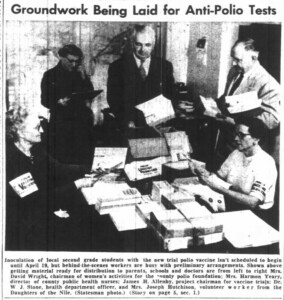
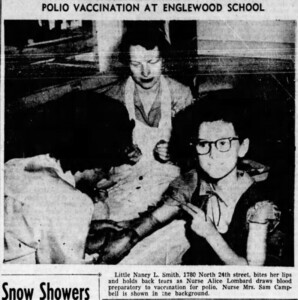
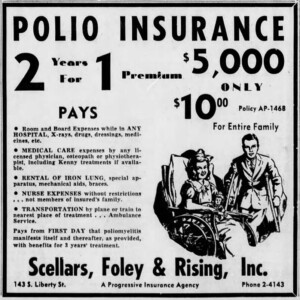
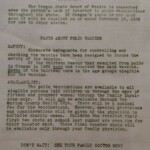
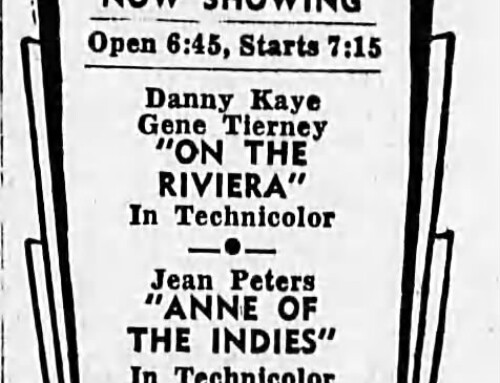
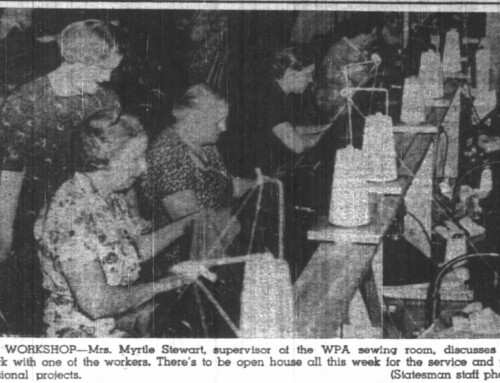
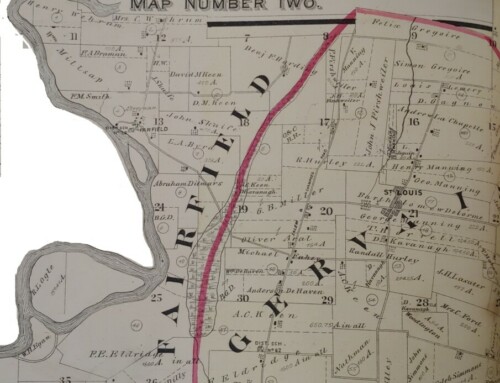
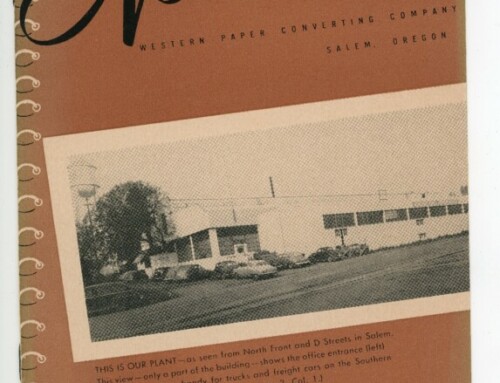
Leave A Comment